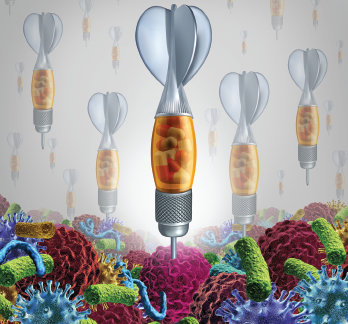
Lightspring / shutterstock.com
CHICAGO—With an ever-strengthening foundation beneath the pathophysiology and prediction of rheumatoid arthritis (RA), the field may soon focus more intently on prevention, an expert said at the 2018 ACR/ARHP Annual Meeting. The session also covered the latest in remission targets and therapy de-escalation.
RA Prevention
Kevin Deane, MD, PhD, associate professor of medicine and principal investigator on the Strategy for the Prevention of RA (StopRA) trial (funded by the National Institutes of Health [NIH]), wanted to spread “enthusiasm that within the next few years, rheumatology will be taking new ‘Intent to Prevent’ approaches to our diseases,” he said, using a phrase introduced by Marvin Fritzler, MD, PhD, of the University of Calgary, Canada.
Growing confidence in understanding the pathophysiology of RA and, in turn, predicting who will develop disease undergirds this shift, he said. Increasing elevations of anti-citrullinated protein antibodies (ACPAs) and cytokines are seen as clinical RA approaches, driven by an understanding of a shared epitope and such risk factors as female sex, smoking, diet, obesity and what we breathe, even though the mechanisms remain murky. A key, underexplored issue is the timing of the influence of these factors, Dr. Deane said.
Multiple studies have shown systemic autoimmunity in the absence of arthritis, making the case that RA-related autoimmunity starts outside the joints, with mounting evidence pointing to the mucosa.1,2
“Knowing when and where RA starts can ultimately lead to effective interventions,” Dr. Deane said.
Prospective studies of ACPA-positive patients with and without rheumatoid factor have shown positive predictive values of 30–60% for RA development within two to six years.
Dr. Dean said, “One, you want to know if someone’s going to get rheumatoid arthritis in their lifetime based on what you can see now. Two, you want to have a sense of when that’s going to happen, both to talk to them,” and as a practical measure for developing clinical trials on prevention that don’t need to follow patients for a long period of time—trials that are essentially unfundable.
A theme underlying RA prevention trials now is that medium to high ACPA titers, combined with a look at symptoms, can provide an idea of how long a patient has until they develop RA, Dr. Deane said.
Risk scores, more refined treatment geared to prevention and assessing biomarkers and events in follow-up to gauge treatment success all could be in the offing, Dr. Deane said.
Once clinically evident disease appears, a patient will likely have RA “forever,” Dr. Deane said, but earlier treatment still means better outcomes, with fewer irreversible changes to the immune system. Prevention also makes sense from a financial standpoint.
“If I can get to the point where I’m actually keeping people in a prevention state where they’re not that sick, and I can see them and keep them well, I think that’s financially going to be an important model going forward for rheumatologists,” he said.
RA Remission Targets
Daniel Aletaha, MD, MSc, associate professor of medicine and consultant rheumatologist at the Medical University of Vienna in Austria, said clinicians assessing RA remission should keep several subtleties in mind. A long-time cornerstone for assessing disease severity, the Disease Activity Score-28 (DAS28), is not particularly good at assessing remission, said Dr. Aletaha, who co-developed two other disease severity measures, including the Clinical Disease Activity Index (CDAI) and the Simple Disease Activity Index (SDAI).
Because it was developed based on moderate to high disease activity, the DAS28 tends to underestimate disease activity, and its remission cut-off covers many patients with two or more swollen joints, which most clinicians would not consider real remission. And studies have found that lowering the cutoff for remission would not fix the problem, Dr. Aletaha said.3
And yet the DAS28 remains a common tool used to assess remission in clinical trials rather than the ACR/EULAR criteria, which rely on the SDAI and CDAI. That’s because the DAS28 is more highly powered to detect so-called “remission,” Dr. Aletaha said. Using the ACR/EULAR criteria would require two to five times more patients for the same power, depending on the trial and the endpoint, he said.
“This is very appealing for companies doing studies, for investigators doing their own studies, because it’s much easier to recruit 50 people in each arm instead of 250,” Dr. Aletaha said. “But we have to be clear about the fact that the remission endpoint, then, probably is not remission. It’s called remission, but it’s not remission.”
He also drew attention to the role secondary pain from causes such as fibromyalgia and trauma plays in near-miss remission. Many patients fall short of meeting the threshold for remission because of their global scores. This, research has shown, often occurs due to pain stemming from a condition other than the rheumatic disease, he said.4
“We have to understand if people have fibromyalgia or trauma or other problems, these other conditions may impact our outcomes,” he said.
‘The remission endpoint, then, probably is not remission. It’s called remission, but it’s not remission.’ —Dr. Aletaha
Treatment De-Escalation
Vivian Bykerk, MD, director of the Inflammatory Arthritis Center at the Hospital for Special Surgery, said randomized, controlled trials and observational studies have found de-escalating treatment—that is, reducing a dose, discontinuing a medication or doing both systematically—can bring about drug-free remission in some patients, but can sometimes come at the cost of a worse outcome when it doesn’t work.
A 2015 meta-analysis of trials and observational studies showed a range of results, depending on the type of treatment and the study.5 Flare appeared in 63% of patients at four months after de-escalation of conventional synthetic disease-modifying anti-rheumatic drug (DMARD) treatment. Fifteen studies of tumor necrosis factor inhibitors found a 26% flare rate after de-escalation, and 49% after stopping the drugs. For tocilizumab, assessed in three studies, 41% flared by six months after de-escalation at six months, and 55–87% at one year. In three abatacept studies, 34–72% flared at different time points after de-escalation.
And there was twice the risk of loss of remission and low-disease activity if biological DMARDs were stopped at one year compared to continuing them, with a risk for further joint damage, Dr. Bykerk said.
In the pragmatic IMPROVED study (involving assessment every four months with therapy escalation or de-escalation, depending on patient progress), a third of patients achieved drug-free remission if they’d achieved remission at some point. But the results showed it could come at the cost of damage, and the cost savings from the de-escalation were low, Dr. Bykerk said.6 In the SURPRISE study assessing tocilizumab de-escalation, not all patients who de-escalated and then flared regained their prior control of disease activity, she said.7
Researchers in Denmark looked at how well patients fared after their mandatory taper from biologic therapy (by 33% at 15 weeks and 50% by 32 weeks). They found 88% of patients flared in the first year, and 39% failed over two years, with 18% suffering radiographic damage progression. Success predictors included being male, taking only one biologic DMARD, low scores of inflammation and damage on magnetic resonance imaging, and being rheumatoid factor negative.8
Dr. Bykerk said the evidence shows that although drug-reduced remission and drug-free remission are possible, it’s crucial that sustained remission be preserved. And she said the initial treatment strategy could prove particularly important, because an initial inadequate response predicts a failure to achieve drug-reduced or drug-free remission.
From a practical standpoint, de-escalation has challenges, she said. “Worsening in terms of symptoms and impacts may occur between scheduled clinical encounters,” she said. “Worsening may not occur for many months or even one to two years,” when a patient might not have a follow-up visit.
“Personalized strategies of integrated induction followed by de-escalation,” Dr. Bykerk said, “will likely be the key to cost-effective improved care.”
Thomas R. Collins is a freelance writer living in South Florida.
References
- Demoruelle MK, Harrall, KK, Ho L, et al. Anti-citrullinated protein antibodies are associated with neutrophil extracellular traps in the sputum in relatives of rheumatoid arthritis patients. Arthritis Rheumatol. 2017 Jun;69(6):1165–1175.
- Catrina AI, Deane KD, Scher JU. Gene, environment, microbiome and mucosal immune tolerance in rheumatoid arthritis. Rheumatology (Oxford). 2016 Mar;55(3):391–402.
- Mack ME, Hsia E, Aletaha D. Comparative assessment of the different American College of Rheumatology/European League Against Rheumatism Remission definitions for rheumatoid arthritis for their use as clinical trial end points. Arthritis Rheumatol. 2017 Mar;69(3):518–528.
- Studenic P, Smolen JS, Aletaha D. Near misses of ACR/EULAR criteria for remission: Effects of patient global assessment in Boolean and index-based definitions. Ann Rheum Dis. 2012 Oct;71(10):1702–1705.
- Kuijper TM, Lamers-Karnebeek FB, Jacobs JW, et al. Flare rate in patients with rheumatoid arthritis in low disease activity or remission when tapering or stopping synthetic or biologic DMARD: A systematic review. J Rheumatol. 2015 Nov;42(11):2012–2022.
- Akdemir G, Verheul MK, Heimans L, et al. Predictive factors of radiological progression after 2 years of remission-steered treatment in early arthritis patients: A post hoc analysis of the IMPROVED study. RMD Open. 2016 Feb 15;2(1):e000172.
- Kaneko Y, Kato M, Tanaka Y, et al. Tocilizumab discontinuation after attaining remission in patients with rheumatoid arthritis who were treated with tocilizumab alone or in combination with methotrexate: Results from a prospective randomised controlled study (the second year of the SURPRISE study). Ann Rheum Dis. 2018 Sep;77(9):1268–1275.
- Brahe CH, Krabbe S, Ostergaard M, et al. Dose tapering and discontinuation of biological therapy in rheumatoid arthritis patients in routine care—2-year outcomes and predictors. Rheumatology (Oxford). 2018 Aug 28.

